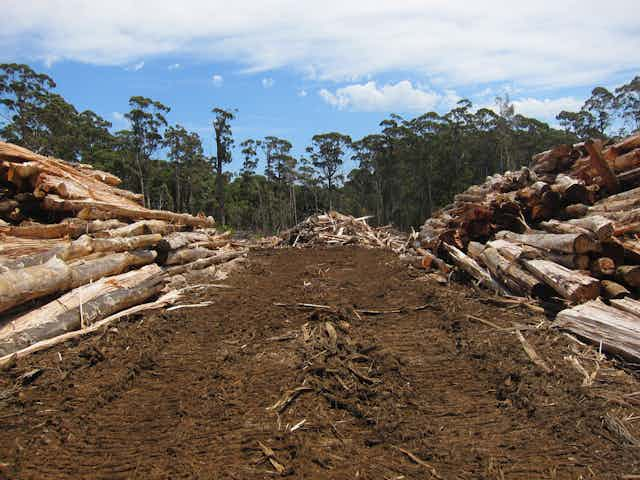The new Tasmanian government has announced the first steps in delivering on its pledge to reinvent the forest industry. Interestingly, this includes not allowing logging for at least six years in 400,000 hectares that were to be reserved under the Tasmanian Forests Agreement — because it is in the best interests of the timber industry.
The government plans to undo the legislation that will create the reserves, but for a period of six years they will not allow logging in these areas. This will allow state-owned Forestry Tasmania to get the Forestry Stewardship Certification demanded by the international wood market. It is also, perhaps, an appreciation that there is no market for the extra wood anyway.
From a government that had promised to “tear up the forest agreement”, it is recognition that the rhetoric of “unlocking” native forests for more logging does not match the market. The needs and demands of the wood market are changing dramatically.
How wood production is changing
Both in Australia, and globally, there has been a profound shift in wood sourcing, from native forest to plantations. Much as food production shifted from natural system exploitation to the deliberate cultivation of agricultural systems (a long time ago), the same is happening for wood production now.
Research just published in Biodiversity and Conservation shows that global wood production from natural forests peaked around 1989 and has been declining since.
The drivers for this change include: decreasing supplies of native forest wood (because of unsustainable native forest harvest rates and declining productivity, particularly in the tropics); increasing native forest production costs (often the cheapest logs to extract are taken first leading to increasing costs as successive forests become more remote); and increasing demand for non-timber services from native forests such as biodiversity, recreation, carbon storage and water quality.
This increasing demand for non-wood values from forests means remaining native forests face a growing range of restrictions on wood production. These include bans on native forest logging (such as in New Zealand and Thailand), increasing areas of forest placed in reserves, and regulations and restrictions on logging that attempt to protect these non-wood values.
Together all these factors encourage investment in plantation wood as a solution to declining supplies and increasing costs for native forest wood.
Over time, growing plantation estates and improving productivity, along with shifts in timber processing technologies and market demands, are fuelling further private investment. At the same time national governments are pursuing wood supply sustainability and self-sufficiency through incentives for plantations.
These trends are reflected in figures released in Australia’s latest State of the Forests Report. Projected annual plantation wood supplies from 2015 are higher than Australia’s annual total log production (plantation plus native forest) of the last decade. An increasingly smaller portion of Australia’s logs are coming from native forests (19% in 2011/12 down from 44% in 2000/2001).
The trends driving these changes are likely to continue into the future. It can reasonably be assumed this transition of wood production, from native forest extraction to tree cultivation, will continue.
How does this affect forest policy in Australia
Given this context, current forest policy discussion in Australia, focused on increasing access to native forest wood, makes little sense. It fails to respond to the main drivers of change in the wood industry. It is out of alignment with the major structural changes occurring in wood production. It looks like an attempt to reinstate a past that is fading, and shows no sign of coming back.
The federal government efforts to undo listing of parts of the Tasmanian Wilderness World Heritage Area are an example of this. From a wood production perspective such actions are unlikely to be any panacea. They will not diminish the demand for forests like these to be protected and valued for uses other than wood. Nor will they cease requests from increasingly affluent, urban and educated global consumers that wood does not come from native forests. Nor will it stop the burgeoning sources of domestic and international plantation wood from undercutting markets for the wood that might be harvested from native forests.
Working against these changes is unlikely to help grow or sustain the wood products industry. If the trends in international and Australian wood production continue (and they are reflected in Tasmania), it is likely that the native forest sector will progressively change to a boutique niche sector. The main game in meeting the bulk of our wood needs will be in the growing and processing of plantation wood. This can be consistent with meeting increasing community and consumer needs for native forests to be used for other things such as biodiversity conservation and recreation.
These were the changes confronted by environmental groups and the forestry industry in settling the Tasmanian Forests Agreement. Now it seems the new Tasmanian Government has given itself some wriggle room, between its election promise to “tear up the forest agreement”, and the need to work with these same challenges.

